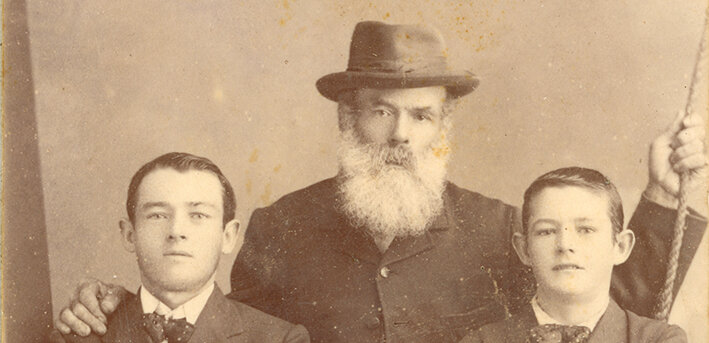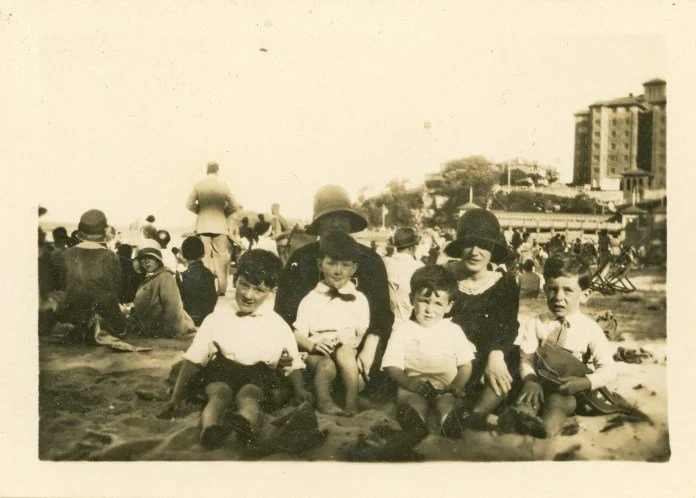
Media reviews.
Micheal McGirr - October 2021
Michael McGirr is the author of Ideas to save Your Life (Text Publishing), Tinteán.org.au.
People often say that the devil is in the detail. But when you come across a book such as this, you’re just as likely to discover that the detail is where angels lurk. Australians of the Great Irish Famine is a feast of storytelling and painstaking historical reconstruction. It seems that Patrick Morrissey has been just about everywhere to unearth the tale of his clan, heading back to the time of Cromwell and even further. It is difficult for the reader not to share Morrissey’s passion for this enormous saga. It is full of extraordinary anecdotes and colourful characters. The sense of life’s possibilities is intoxicating.
At the same time, Morrissey is acutely aware of the many issues presented by the history of any family, not least his own. This is a celebration in the true sense of the word: it is a work of grateful realism rather than conjecture. He sticks to a story he can document: ‘Yet important as these documents are, they don’t provide insights into Irish culture of music, poems and stories that they may have brought with them. This story only relies on what historical records chronicle and personal reflections.’ Morrisey is a craftsman not a fantasist.
Take one thread in this elaborately woven tale. Morrisey is, like many historians, deeply aware of the impact of the Irish famine in the middle of the nineteenth century and indignant about the way it was caused and the manner in which it was used. It created opportunities for those in power and is a lesson in the manipulation of suffering that has been repeated in many contexts before and after. ‘Rotting food fused with social, economic and political oppression.’ In Three Famines, Tom Keneally finds much in common between famines in Ireland, Bengal and Ethiopia, and others beside.
Morrisey’s book charts the journey of his forebears from Ireland to colonial Australia, a less common destination for refugees than the United States. Among them were his great, great uncle, William, who arrived on the Rodney in 1854. William tried his hand as a miner around Bendigo before marrying Kate O’Brien at St Francis, Lonsdale Street, in 1868. He got a job as a gatekeeper on a new railway before he was killed by a train he had not seen coming. Kate then took over the job until she too was killed by a train. On both occasions, their son William found the body. This William, orphaned at 15, went to work on the Wonthaggi coal mine. He married Martha but died young of tuberculosis ‘probably a result of coal mining.’ William and Martha’s son, Royce, was killed on the Western Front in 1916. Morrisey pieces these stories together beautifully. In three generations, we see gold, railways, coal and war sewn through the life of ordinary people. Again and again, a lesson is brought home about the dangerous work undertaken by an immigrant community with limited access to the levers of power.
Morrisey often expresses his thanks to publicly available records that have helped his quest. He sharply observes, however, how much harder it is to recover the stories of women than of men. Indeed, the book concludes on the note that ‘many other women lived long lives and leave no searchable stories.’ As the clan spreads over a wide arc of Australia, he regularly notes the First Nations people whose lands they entered. All of this reveals a broad range of sympathy which draws the reader into a deep appreciation of the complexity of the historian’s task.
Australians of the Great Irish Famine traces a kind of circle. It is, at core, an engrossing narrative of historical power, told through the lens of the Irish experience. Morrisey returns to Ireland to uncover stories of landlords and their tenants which go back centuries. ‘Cromwell’s campaign of terror, motivated by dreams of conquest and confiscation, is estimated to have resulted in about twenty five percent of Ireland’s people dying from fighting and disease.’ Morrisey’s great great grandfather, John, was born about 1784 and saw social upheaval from the bottom rung. It is no wonder that his family were prepared to try their luck on the other side of the world.
The final chapter of this book, perhaps the most trenchant, completes the circle. Morrisey’s mother, Patricia, was honoured for her contribution to the Catholic Women’s League and her community work. Countless others contributed to the Catholic Church in different ways. They were involved in the Movement, the Knights of the Southern Cross and the Holy name Society, rank and file Catholics of great heart. They were not always well served by a clerical culture that put religious authority on a pedestal and revered priests such that they could do no wrong. The story of the cover-up of sexual abuse is shameful. Morrisey sees that it’s not new, ‘the historical context dates back centuries.’ In a story that stretches right across this book, the powerful were blinded by their position: ‘That the church potently used shame and guilt to control the insecure, the dying and the intellectually weak (is) not forgotten.’
Morrisey has served his farflung clan with fidelity and panache. He has honoured the memory of many ordinary, lovable, people. He has also served the wider community by brining to light themes that operate beneath historical events and to which the unaware can be vulnerable. Australians of the Great Irish Famine comes from the heart but challenges our minds. Michael McGirr is the author of Ideas to save Your Life.”
Mary Flood - January 2021.
Mary Flood, Kilkenny Archaeological Society.
“… forensically examined source materials … an impeccable account of a family along their trajectory … should be read by everyone interested in their nineteenth century family origins in Ireland … A rich literary legacy”.
From Ireland to ‘Manly by the Sea’
By Ian Freestone Manly Observer : manlyobserver.com.au/from-ireland-to-manly-by-the-sea/
November 9, 2021
Millie (on right) with her two boys, Manly Beach, 1930. Morrisey Collection.
Ian Freestone sits down with Patrick Morrisey to talk about his new book, ‘Australians of the Great Irish Famine – One Clan’s Story’.
The wind blows in the old pine trees
Sweet scents from tropic isles,
And fanned by each caressing breeze
The lazy ocean smiles.
So come, dear heart, to Love’s own land,
Romance is calling me
To roam beside her on the strand
Of Manly-by-the-Sea
Local pianist and Balgowlah resident, Millie Morrisey (1890-1985), treasured her copy of the 1920s prize-winning song ’Manly by the Sea’. One can imagine her sitting at her walnut 1890s grand piano in her North Harbour Californian bungalow looking eastward toward Manly and belting out the chorus:
On golden sands of Manly shore
And white surf rolling free
Where beauty dwells for evermore
Sweet Manly by the sea
Millie Morrisey is the late grandmother of Patrick Morrisey, a local historian and author, who has just published ‘Australians of the Great Irish Famine – One Clan’s Story’.
“When my parents died I realized I was now part of the oldest generation and I thought about my children not knowing where they came from and their cousins not knowing. So I began to research,” says Morrisey.
Millie’s musical score, Manly by the Sea. Morrisey Collection
Respected book reviewer, Michael McGirr, rightly notes, Morissey’s four year long project is a “feast of story telling and painstaking historical construction”.
Patrick Morrisey’s family clan began emigrating to Australia from Ireland in the mid 1800s and the book traces that journey across three generations. In these stories, gold, railways coal and war are sewn into the lives of ordinary people.
Its a fascinating and compelling journey that eventually brings the family to Manly ‘by the sea’, where Andrew Morrisey, who married Millie, was appointed manager of the new ‘McIlrath Grocery’ store on the Corso in 1921. Then, after paying a one pound building fee, Andrew built his home at North Harbour and married Millie in 1925.
Millie in her wedding dress, 1925. Morrisey Collection
As devout Catholics, and regular attenders at St Mary’s, Andrew and Millie, would have been overawed by the ‘rivers of worshippers’ that descended on Manly for the annual feast day of Corpus Christi. Estimates of between 70,000-100,000 people at that time would make their way up Eastern Hill to St Pat’s. Morrisey’s book details the complex, and oftentimes dark, history of the Catholic Church with special attention given to St Cecilias which opened in Balgowlah in 1929. With all the smarts of an astute property developer, Archbishop Sheehan declared to the faithful at the church opening, “I have no doubt that when the Harbour Bridge is completed, the north side, with its healthy building sites and beautiful scenery, will soon become brimful of population.”
Millie’s family home, Balgowlah.
But only a few years after they were married Millie lost her husband Andrew to myocarditis, a condition attributed to active service in WW1. He died in ‘Fairlight Hospital’ (cnr of Boyle St and White St). Millie, aged 38, having already lost both parents, all her siblings, and now widowed with two very small children to raise during the Great Depression, threw herself into community and church projects. She would live in her brick bungalow until her death in 1985, aged 95.
Author, Patrick Morrisey with the new book.
“History is like fine art; it deserves to be cultivated for its own sake; it possesses its own type of attractiveness; and in the hands of one with human sympathies, can be made far more gripping than those works of fiction on which we waste so much of our time”. (Archbishop Sheehan, 1929)
Morrisey’s, “Australians of the Great Irish Famine” is indeed a “gripping” work of non-fiction. Those interested in Manly’s history and its people, as well as those who love reading a well-researched book, will be absorbed by the Morrisey clan story and the insights it provides into early Australian history and the extensive contribution of our Irish forbears.
McILrath’s Grocers, Manly, 1948. Courtesy of Manly Library
Australians of the Great Irish Famine: One Clan’s story is on sale for $35 at pjmpublications.com.au or by calling 0427 700640. A book launch with live Irish Music will be held on 2 December 2021. Details on the book’s website.
Patrick was interviewed by Ian Freestone for this Manly Observer article. Ian is manager of Manly-based, Scanned and Secure – helping others conserve and digitise photos, slides and film: www.scannedandsecure.com.au Phone/Text 0417 252958





